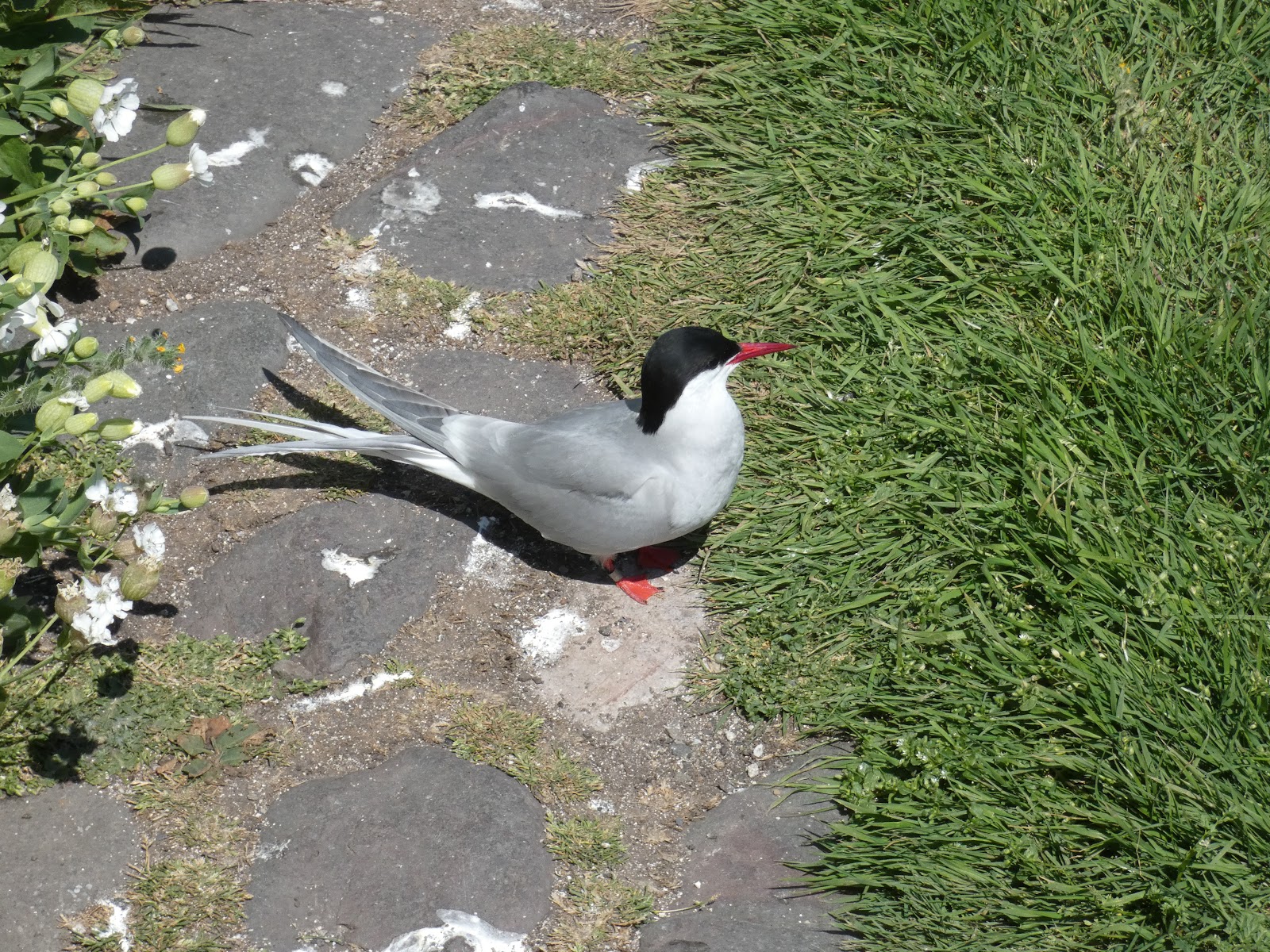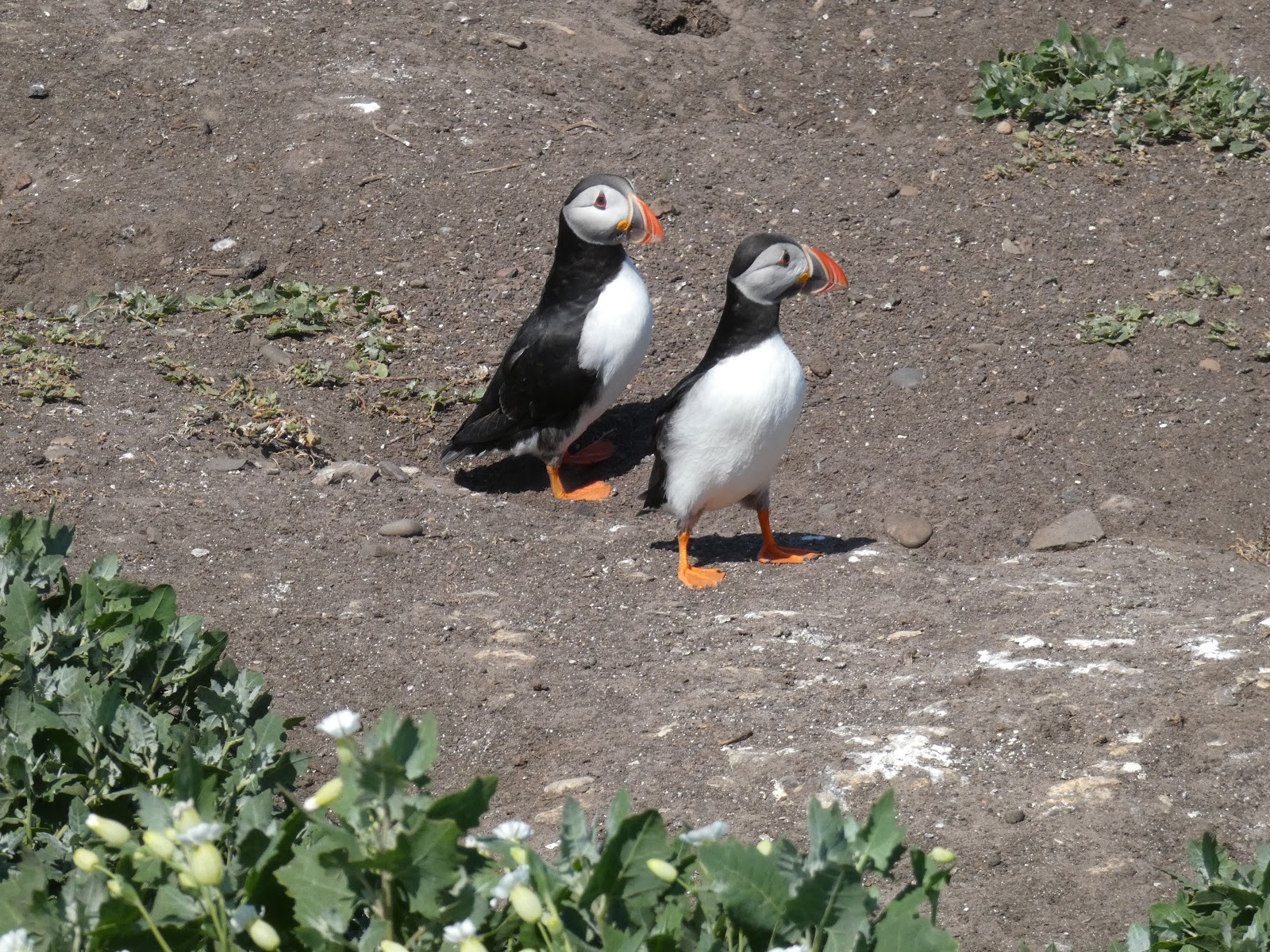Just as my trip to Spain came about because of an inability to stay on Fair Isle, my Northumberland visit was a result of having to reset my plans to visit Skomer Island in Pembrokeshire. Skomer is a great place to see (Atlantic) Puffins at point blank range and my wife was keen to go back there, having enjoyed a trip there with our kids quite some years ago. However, I fortunately checked boat availability a couple of weeks in advance and discovered every boat was sold out until July 22! Since we were also planning to visit Edinburgh and the Lake district, I decided to try the Isle of May near Edinburgh. However, availability seemed problematic here as well and I wasn't sure how close we could get to the birds. At that point, I looked into the Farne Islands and it was apparent there was plenty of availability as long as we booked a week or so in advance.
Since I knew that Coquet Island had the major UK colony of Roseate Terns, I started to look into how to see that species. Coincidentally, I had been been discussing the identification of an apparent hybrid Blue-winged Teal with Colin Bradshaw on an on-line forum and recalled he was from the northeast of the UK. I contacted Colin and he told me I needed to get on the seabird special boat trips to Coquet Island for the terns. Colin also sent me several suggestions for castles, quaint villages and restaurants, as well as suggestions for several other interesting birds. Also this resulted in us deciding to spend several days in the area, combining some time up in the Pennines with three days along the coast.
We first visited the area around Teesdale and then Blanchland, staying near Derwent Reservoir. Arriving on the afternoon of June 15, we visited Bowlees and the waterfalls of High and Low Force. This was strictly casual birding as Remy and I hiked to see the waterfalls, but I was delighted to hear several Willow Warblers singing, as this formerly common species has deserted the lowland areas of southern England despite being a common breeder on the Bristol Downs in my youth. I also snagged another greatly declined summer visitor in Spotted Flycatcher, as well as a few Grey Wagtails and a Common Sandpiper.
Heading towards our bed and breakfast on a road across the open moors, we hit a small pothole. Unfortunately, our rental car was a model with sports wheels, which I knew from bitter experience don't handle potholes well. Sure enough, we had a flat and naturally there was no spare tire. Even worse it was a Sunday. Luckily, the tire was not yet totally flat, so I decided to see if we could make it to Stanhope, a village about 5 miles away. We just about got there with the tire starting to separate but the garage we initially found didn't do repairs. After a quick internet search I found there was a repair shop just a few hundred yards away and left the car there with a plan to call the next morning. We lucked out finding an Uber to take us to our accommodation over eight miles away. I hated to think how we would have fared in the pre-internet and smartphone days!
After settling into our bed and breakfast, I headed out for a short walk around the nearby moorlands and enjoyed bubbling Curlews, Oystercatchers and Lapwings. The next morning, we contacted the garage and they confirmed they could get the tire replacement done by the afternoon. I went out on another walk up the valley through open fields and some gorse scrub and up on to the edge of the heather moors. I had a similar collection of breeding waders augmented by a couple of Redshanks and a (Common) Snipe. A Reed Bunting, three Red Kites and a (Common) Buzzard and a few Sand Martins (Bank Swallows for US readers) were hanging around in the same area. Several Stock Doves provided visual relief from the constant parade of Wood Pigeons that now dominates birding in the UK. Up on the edge of the moors, the familiar 'go-back' calls alerted me to a couple of Red Grouse, which I was able to see perched up on the slope. A closer approach failed to refind them but turned up a family of (Northern) Wheatears.
Late afternoon I was finally able to pick up the car and take advantage of the birding sites Colin had sent me details about. That evening, I drove over to Winnow's Hill to look for (Eurasian) Nightjar in a young forestry plantation. I was able to hear and see the Nightjar well while the light was still good. In addition a (Eurasian) Woodcock flew over, but I did not hear it roding.
The next morning, I got up at 4.30 AM and headed over to the Black Grouse lek at Langdon Beck. There were 21 males in all at the lek with some intermittent display activity. The birds were far enough from the road that a 40x scope was really necessary to get high quality views. However, since I had seen the lek much closer at Worlds End in North Wales just the previous year, I wasn't too bothered by the distance and just enjoyed their antics. After that I headed over towards Cow Green Reservoir with a plan to hike to the Falcon Clints, an area for Ring Ouzels. As I approached the area, I found I had to park over a mile from where the appropriate habitat would start. Given my limited time and the very windy and overcast conditions. I aborted the plan and headed back to our bed and breakfast.
After breakfast, we checked out and headed towards the coast. I dropped in on Amble Harbor so I could book the Seabird Special boat trip to Coquet Island for the evening of the next day. We then headed up to Craster and walked along the coast to the castle there. (Common) Eiders were scattered along the coast here, including some females with ducklings and various seabirds passed by. The wind kept most passerines from showing too well, but I did hear a Yellowhammer, another formerly common species that has drastically declined over the last five decades.
The next day was spent on family exploration of the Bamburgh area and late afternoon I headed back down to Amble to catch the Coquet boat. The North Sea is relatively enclosed and the prevailing winds are usually from the west, meaning there are no swells like on the Pacific coast of North America. This allowed the boat to get very close to the rocks and provide a steady viewing platform.
As we approached the island, we could see Herring Gulls, (Great) Cormorants, (Common) Eiders and a few Ruddy Turnstones loafing on the flat rock areas on the north tip of the island. There was a constant stream of Puffins passing by along with a few terns, Gannets and Common Murres (Guillemots). Careful scanning of the low cliffs turned up about a dozen each of Fulmar and Razorbill among the masses of Puffins and Kittiwakes. Eventually we got around to the southeast side where small numbers of terns were loafing on the rocks. The first group appeared to be all Arctics, but getting in close to a set of nest boxes revealed some Roseate Terns, several of which perched on the low rocks close to the boat and gave really good looks in comparison with Common Terns and the odd Sandwich Tern. The Roseates were very distinctive due to their paler, whiter upperparts, longer, all-black bills and pinkish flush to their underparts. Their calls were also very distinctive. We got to watch the Roseates for probably 20-30 minutes, a really magical experience with a species I last saw over a decade ago in Taiwan and one I have seen less than ten times in my life.
In addition to studying the Roseates, I also looked closely at the Common and Arctic Terns as these are difficult to see from shore these days in California. Arctics are almost always out by the shelf waters and hardly ever occur on the coast itself. Commons have been declining for decades now and I see just a handful a year these days, if that. I was surprised by how grey below most of the Commons appeared and I will now be attaching much less importance to that alleged distinction from Arctic Tern in the future.
The next day, Remy and I took a boat to the Farne Islands, one of the UK's many world-class seabird colonies. The initial part of the boat trip took us around the colonies on the outer islands, where we saw large numbers of nesting Kittiwakes and Common Murres (Guillemots) and (Atlantic) Puffins. We noticed several incidences of Puffins taking off en masse in panic due to a Great Black-backed Gull flying by and on one of these witnessed the gull grab a Puffin. Fortunately, there are only eight pairs of Great Black-backed Gulls on the Farnes and tens of thousands of Puffins.










Comments
Post a Comment